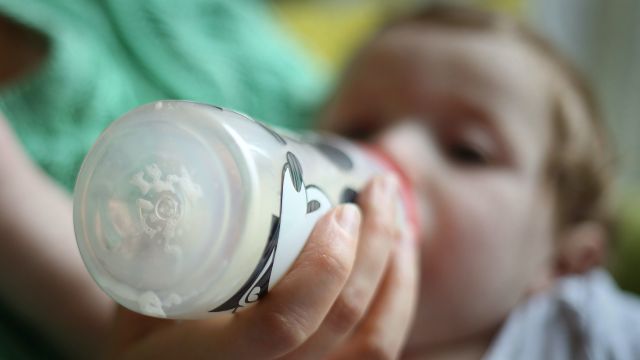The research also indicated a strong relationship between heat and the release of microplastics, such that warmer liquids result in far greater release.
Researchers say annual production of polypropylene accounts for 20% of non-fibre plastic production and it is the most widely used plastic in food preparation.
However, they add little is known about microplastic release from these types of containers.
Scientists tested microplastic release in 10 types of infant feeding bottles – representing the majority of the bottles found in the global online market – under World Health Organisation-recommended sterilisation and formula preparation conditions.
The feeding bottles were either made of polypropylene or included polypropylene-based accessories.
We have found that it is possible to mitigate the risk of ingesting microplastics by changing practices around sterilisation and formula preparation
The study found that microplastic release varied between 1.3 to 16.2 million particles per litre among the bottles.
It also found the bottles continued to release microplastics over a 21-day test period and microplastic release varied according to different factors, such as water temperature.
However, the scientists cautioned there is not enough data on the consequences of microplastics on infant health and say they do not want to worry parents.
The researchers involved were from AMBER, the SFI Research Centre for Advanced Materials and Bioengineering Research, TrinityHaus and the schools of engineering and chemistry at Trinity College Dublin.
Professor John Boland, of AMBER, CRANN, and Trinity’s School of Chemistry, said: “When we saw these results in the lab we recognised immediately the potential impact they might have.
“The last thing we want is to unduly alarm parents, particularly when we don’t have sufficient information on the potential consequences of microplastics on infant health.
“We are calling on policymakers, however, to reassess the current guidelines for formula preparation when using plastic infant feeding bottles.
“Crucially, we have found that it is possible to mitigate the risk of ingesting microplastics by changing practices around sterilisation and formula preparation.”
In the study published in Nature Food, the authors used these data to model the potential global exposure of infants to microplastics.
They estimated that, on average, infants are exposed to 1.6 million microplastic particles per day during the first 12 months of life when fed using polypropylene-based bottles.
They also found the exposure modelling varied by region, with infants in Africa and Asia having lowest potential exposure while infants in Oceania, North America and Europe have the highest potential exposure.
The researchers concluded that infants may be exposed to higher levels of microplastics than previously thought.
They say more research is needed to understand how plastics that come into contact with food release microplastics during everyday use.
Professor Liwen Xiao, at TrinityHaus and Trinity’s school of engineering, said: “Previous research has predominantly focused on human exposure to micro and nanoplastics via transfer from ocean and soils into the food chain driven by the degradation of plastics in the environment.
“Our study indicates that daily use of plastic products is an important source of microplastic release, meaning that the routes of exposure are much closer to us than previously thought.
“We need to urgently assess the potential risks of microplastics to human health.
“Understanding their fate and transport through the body following ingestion is an important focus of future research.
“Determining the potential consequences of microplastics on our health is critical for the management of microplastic pollution.”







